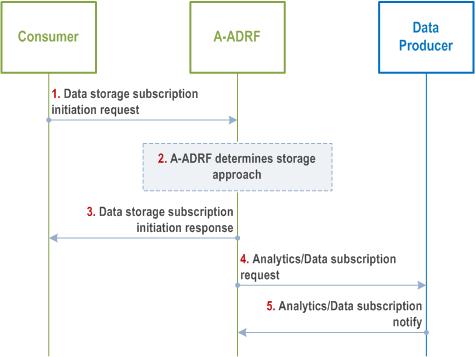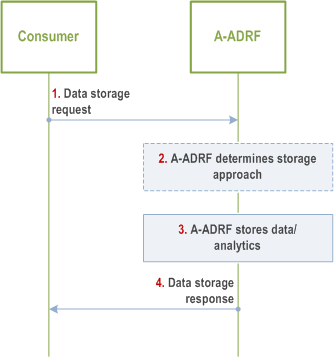Content for TS 23.436 Word version: 19.3.0
0…
5…
6…
8…
8.3…
8.4…
8.5…
8.6…
8.7…
8.8…
8.9…
8.10…
8.11…
8.12…
8.13…
8.14…
8.15…
8.16…
8.17…
8.18…
8.19…
9…
9.3…
9.4…
10…
A…
8.10 Procedure on support for analytics storage
8.10.1 General
8.10.2 Procedure
8.10.3 Information flows
...
...
8.10 Procedure on support for analytics storage |R19| p. 66
8.10.1 General p. 66
This clause describes two procedures for supporting data storage to A-ADRF.
8.10.2 Procedure p. 66
8.10.2.1 Notification based data storage p. 66
Figure 8.10.2.1-1 illustrates the procedure for consumer to request A-ADRF to initiate request for data or analytics to store.
Pre-conditions:
- Analytics or data consumer requests ADAE server, A-DCCF or data sources to store analytics or data to A-ADRF.
- ADAE server, A-DCCF or A-ADRF are configured with default operator storage policies.

Step 1.
The consumer (A-DCCF or ADAE server) determines that data and/or analytics needs to be stored to the A-ADRF, or requests the A-ADRF subscribes to Data Producer for receiving notifications. The determination may be made based on configuration or information supplied by the data or analytics. As specified in Table 8.10.3.2-1, the request to the A-ADRF specifies the data and/or analytics to which the A-ADRF will subscribe. The request includes identity of the consumer, security credential(s) for authorization and verification, Storage Handling information (e.g. a lifetime for how long the data or analytics should be stored, indicate that a notification alerting the consumer be sent prior to data deletion from the A-ADRF).
Step 2.
The A-ADRF may, based on implementation, determine whether the same data and/or analytics is already stored or being stored, based on the information sent in step 1 by the consumer. Based on Storage Handling information, the A-ADRF determines the Storage Approach (e.g. lifetime for storing data and whether consumer is notified prior to data deletion).
Step 3.
If the data and/or analytics is already stored and/or being stored in the A-ADRF, the A-ADRF sends data storage subscription response message to the consumer indicating that data and/or analytics is stored. As specified in Table 8.10.3.3-1, the A-ADRF includes the Storage Approach if determined in step 2.
Step 4.
The A-ADRF subscribes to the data producer (e.g. A-DCCF, ADAE server) to receive notifications with data or analytics, providing its notification endpoint address and a notification correlation ID.
Step 5.
The data producer sends data or analytics notifications containing the notification correlation ID provided by the A-ADRF to notification endpoint address. The analytics or data notifications shall contain timestamp. The ADRF stores the notifications.
8.10.2.2 Direct data storage p. 67
Figure 8.10.2.2-1 illustrates the procedure for the consumer to request A-ADRF for data or analytics storage.
Pre-conditions:
- ADAE server or A-DCCF has data or analytics need to store to A-ADRF.
- ADAE server, A-DCCF or A-ADRF are configured with default operator storage policies.

Step 1.
The consumer (e.g. ADAE server, A-DCCF) sends data storage request to the A-ADRF for storing data and/or analytics. The request message includes identity of the consumer, security credential(s) for authorization and verification, collected data with timestamp and/or analytics with timestamp, Storage Handling information (e.g. a lifetime for how long the data or analytics should be stored, indicate that a notification alerting the consumer be sent prior to data deletion from the A-ADRF), as specified in Table 8.10.3.4-1.
Step 2.
Based on Storage Handling information (if available), the A-ADRF determines the Storage Approach (e.g. lifetime for storing data and whether consumer is notified prior to data deletion).
Step 3.
The A-ADRF stores the data and/or analytics sent by the consumer. The A-ADRF may, based on implementation, determine whether the same data and/or analytics is already stored or being stored based on the information sent in step 1 by the consumer and, if the data and/or analytics is already stored or being stored in the A-ADRF, the A-ADRF decides to not store again the data and/or analytics sent by the consumer.
Step 4.
The ADRF sends data storage response message to the consumer indicating that data and/or analytics is stored, whether the A-ADRF determined at step 3 that data or analytics is already stored and the Storage Approach, as specified in Table 8.10.3.5-1.
8.10.3 Information flows p. 68
8.10.3.1 General p. 68
The following information flows are specified for data storage based on clause 8.10.2.
8.10.3.2 Data storage subscription request p. 68
Table 8.10.3.2-1 describes information elements for the data storage subscription request from the consumer (ADAE server, A-DCCF) to the A-ADRF.
| Information element | Status | Description |
|---|---|---|
| Consumer ID | M | The identifier of the consumer (ADAE server, A-DCCF). |
| Data Producer ID | O | The identifier of the data producer (e.g. ADAE server, A-DCCF). |
| Analytics ID | O | The identifier of the analytics event. This IE shall be provided when Analytics Producer ID is present. |
| Analytics Type | O | The type of analytics for the event, which include category (e.g. statistics or predictive analytics), may include mode (e.g. offline or online) and indication on ML-enabled analytics. This IE shall be provided when Analytics Producer ID is present. |
| Target Data Producer Profile Criteria | O | Characteristics of the data producers to be used. This IE shall be provided when Data Producer ID is present. |
| Area of Interest | O | The geographical or service area for which the subscription request applies. |
| Time Validity | O | The time validity of the subscription request to the A-ADRF. |
| Storage Handling information | O | The information for storage handling. |
| > Lifetime | O | A lifetime for how long the data or analytics should be stored. |
| > Alert Indicator | O | To indicate that a notification alerting the consumer be sent prior to data deletion from the A-ADRF. |
8.10.3.3 Data storage subscription response p. 69
Table 8.10.3.3-1 describes information elements for the data storage subscription response from the A-ADRF to the consumer (ADAE server, A-DCCF).
| Information element | Status | Description |
|---|---|---|
| Result | M | The result of the data storage subscription request (positive or negative acknowledgement). |
| Storage Approach | M | Represent the Storage Approach (e.g. lifetime for storing data, and whether consumer is notified prior to data deletion). |
8.10.3.4 Data storage request p. 69
Table 8.10.3.4-1 describes information elements for the data storage request from the consumer (ADAE server, A-DCCF) to the A-ADRF.
| Information element | Status | Description |
|---|---|---|
| Consumer ID | M | The identifier of the consumer (ADAE server, A-DCCF). |
| Data Type | M | To indicate the data type (e.g. data or analytics). |
| Content | M | The data or analytics to be stored. |
| Timestamp | M | The timestamp of the data or analytics. |
| Analytics ID | O | The identifier of the analytics event. This IE shall be provided if the Storage Type is analytics. |
| Analytics Type | O | The type of analytics, which include category (e.g. statistics or predictive analytics), may include mode (e.g. offline or online) and indication on ML-enabled analytics. This IE shall be provided if the Data Type is analytics. |
| Data Source Information | O | Information of the data source. This IE shall be provided if the Data Type is data. |
| Storage Handling information | O | The information for storage handling. |
| > Lifetime | O | A lifetime for how long the data or analytics should be stored. |
| > Alert Indicator | O | To indicate that a notification alerting the consumer be sent prior to data deletion from the A-ADRF. |
8.10.3.5 Data storage response p. 70
Table 8.10.3.5-1 describes information elements for the data storage response from the A-ADRF to the consumer (ADAE server, A-DCCF).
| Information element | Status | Description |
|---|---|---|
| Result | M | The result of the data storage request (positive or negative acknowledgement). |
| Storage Approach | M | Represent the Storage Approach (e.g. lifetime for storing data, and whether consumer is notified prior to data deletion). |